

The customer journey is being redrawn right in front of our eyes.
Marketers once worked with predictable-ish funnels. But with AI driving new ways to search and buy, the definition of the “standard” customer journey is shifting.
Discovery doesn’t start with Google anymore; it starts in a chatbot, a TikTok feed boosted by generative recommendation engines, or a voice query to a smart speaker. Consideration isn’t bouncing between a million tabs; it's an AI summary of reviews and product comparisons. And decisions? They’re collapsing into a single click, sometimes within the AI tool itself.
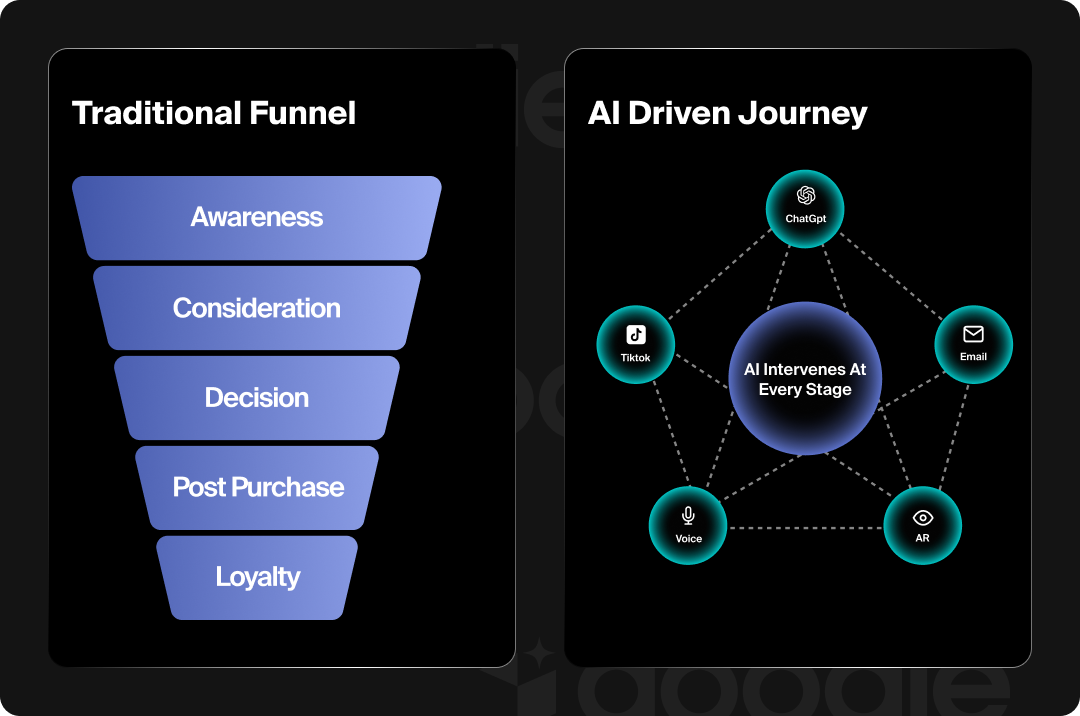
AI is now embedded across channels: customer service chats, social feeds, product pages, inboxes, and even AR try-ons. From ChatGPT’s new “buy direct” feature to AI-engineered review summaries, artificial intelligence is quietly but aggressively reshaping the way customers move from first touch to long-term loyalty.
AI already influences how your customers discover, compare, and decide. The only question is: does it spotlight you, or skip you?
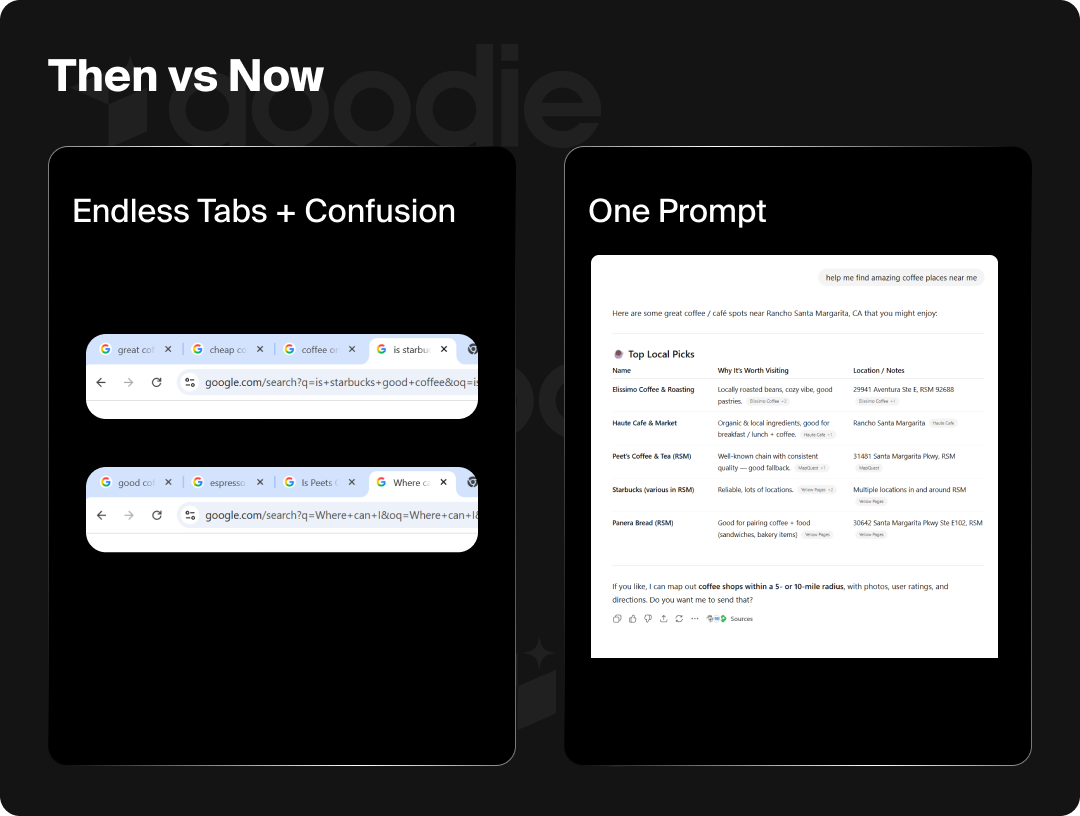
Meet Julia (no relation). Five years ago, Julia’s purchase journey would have started with a simple Google query, likely racking up a few ad impressions along the way, even checking several product review blogs. But today, Julia’s journey from discovery to purchase looks very different. Within seconds, she gets recommendations and links for product dupes and even the exact brand the person in the videos is wearing… some purchasable directly within ChatGPT.
This is the reality of the modern customer journey. The traditional discovery stage is collapsing, and customers don’t move slowly down the funnel anymore. They’re nudged toward decisions by AI-mediated touch points from the very beginning. You can’t count on the customer following a nice, clean, linear path anymore.
What this means for brands: You can’t win by spraying impressions at the top of the funnel with the goal of slowly nurturing intent. Discovery is more often the stage where brands win the purchase or lose it (sometimes in mere seconds).

Discovery is now a zero-sum game, folks. Either your brand is included… or your competitors are.
A few years ago, Julia might’ve spent hours toggling between YouTube reviews, Reddit threads, and comparison blogs before deciding what to buy. Now, when she asks ChatGPT, “What's the best retinol serum for clogged pores?” she gets more than a list; she gets a full, side-by-side breakdown of ingredients, summarized product reviews, and Reddit sentiment neatly condensed into one clean package of an answer.
If she wants a second opinion, she can even get citations from dermatology resources and medical reviews she likely wouldn’t have been willing to search for herself. With the help of AI, the research phase that once took hours now takes minutes, and she’s able to make an even more informed purchase.
AI has collapsed the consideration stage into a single interface. Instead of scattered touch points, consumers rely on aggregated, AI-curated perspectives that feel objective and complete. The challenge is that the summaries are only as inclusive as the data they’re trained on.
If your brand isn’t mentioned, cited, or favorably represented across review websites, help centers, social threads, and news outlets, AI may synthesize the entire market…without you in it.
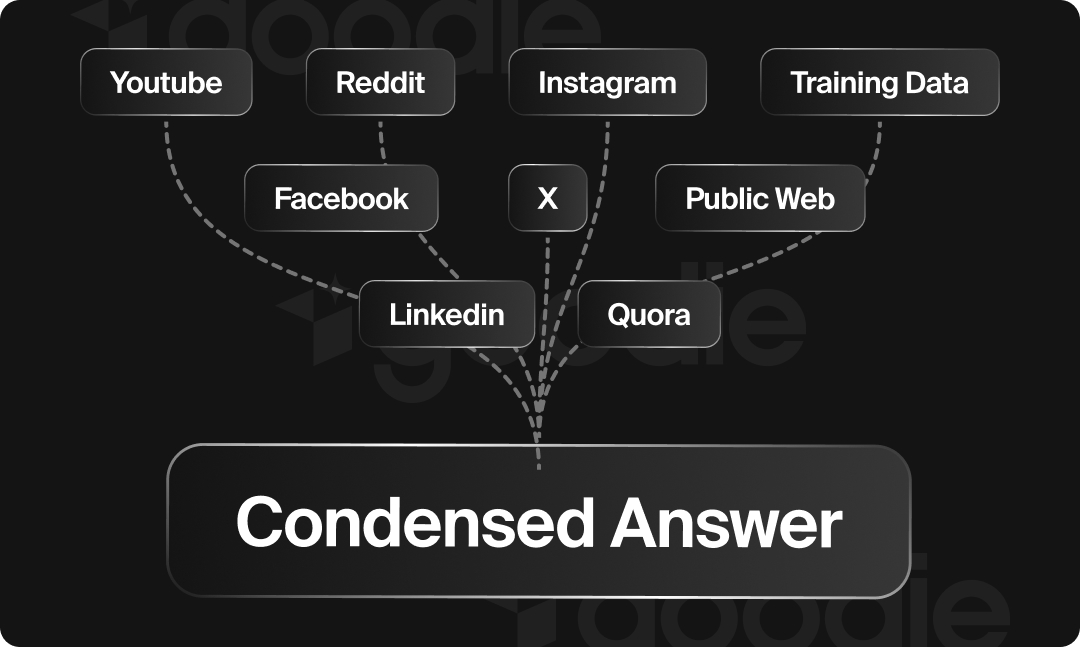
What this means for brands:
The consideration stage, as we know it now, means we aren’t competing for clicks, but instead we’re competing for inclusion.
By the time Julia reached the decision phase, she had seen the top recommendations across multiple AI interfaces; all cross-references, summarized, and personalized to her past behaviors. ChatGPT shows her where to buy. TikTok’s generative rec engine pushed creator videos featuring the same skincare she just researched. Her inbox surfaces a discount email, generated by the retailer’s predictive AI, before she’s even added the item to her cart.
The “research, compare, decide” process is now seemingly instantaneous. Julia isn’t clicking through ten retailer websites, but only clicking once. And now, that click may even happen directly within the AI tool itself.
AI has erased the clean line that connects the consideration stage with the conversion stage. The system that surfaced options is also facilitating the transaction. And in that seamless handoff, brands lose the ability to control the context of this decision, unless they’re strategically visible within it.
This collapse of the funnel is where AI’s ability to influence is the most tangible. You’re no longer a salesman persuading someone to buy. You need to make sure you’re present in the running. If you aren’t represented when the recommendations are made, you’re unfortunately out of the running.
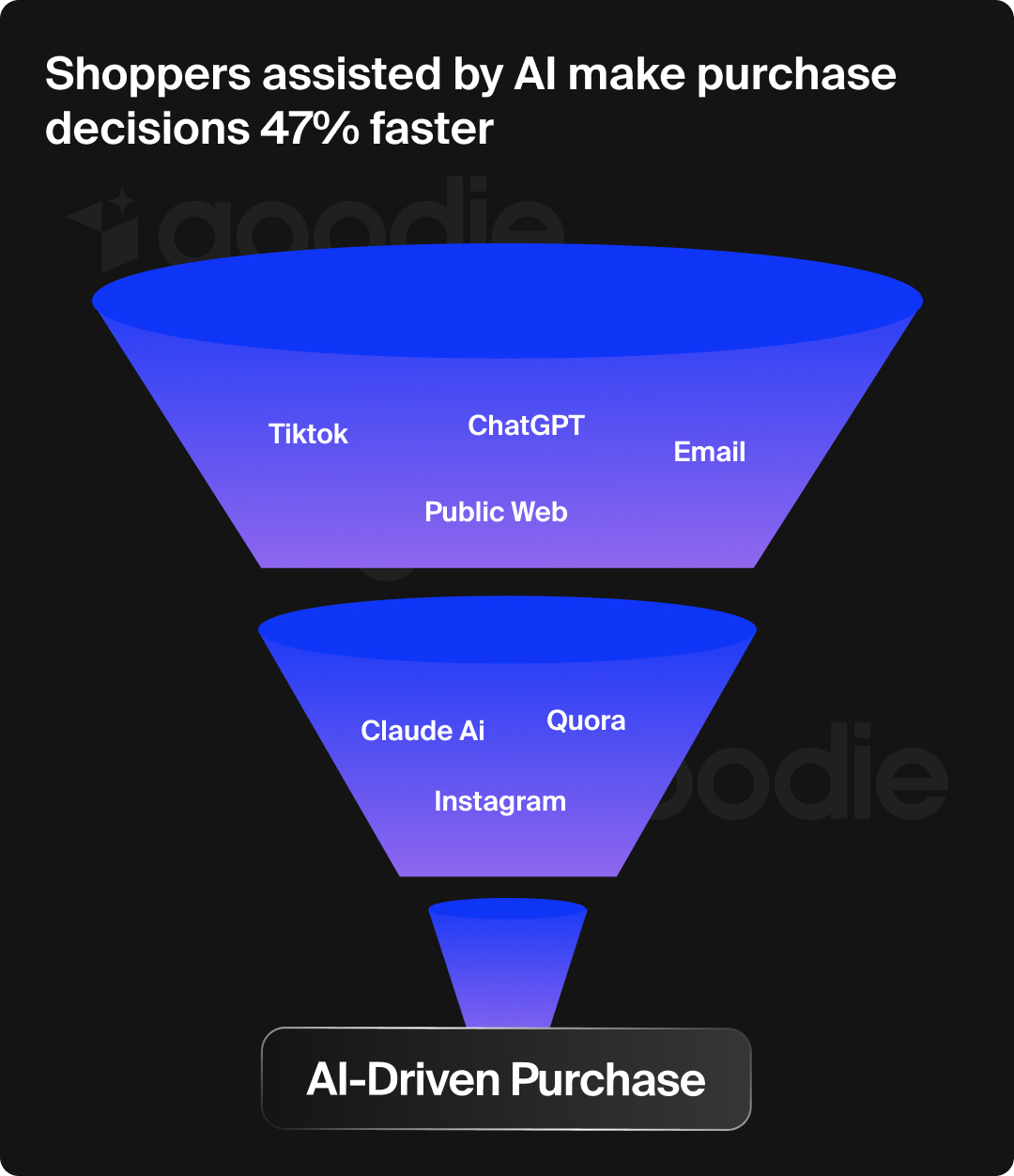
What this means for brands:
AI is not only guiding purchase decisions and helping customers complete the cycle. If your brand isn’t optimized for AI-driven commerce, you risk missing out on the moment customers are ready to buy.
Julia’s interaction with the brand doesn’t end at checkout; it just changes the channels. Minutes after her purchase, she gets an AI-generated confirmation email that anticipates her next questions: shipping time, return options, and tips based on her purchase.
A week later, the retailer’s virtual assistant enters the chat with a follow-up, offering product assistance before she’s even thought to ask. When Julia posts a review, the brand’s sentiment analysis system identifies her as a satisfied customer and automatically enrolls her in a loyalty perk. Across every touchpoint, inbox, chat, and even social, Julia’s post-purchase production is orchestrated by AI that listens, predicts, and responds.
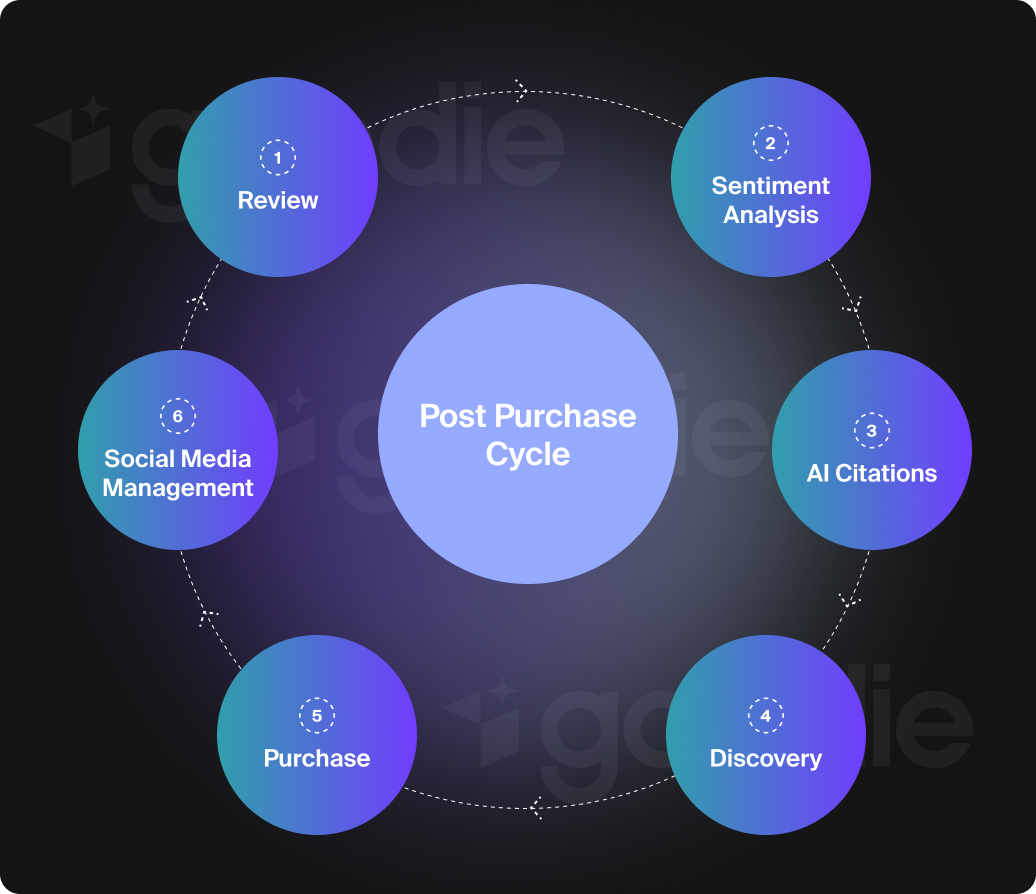
Post-purchase shouldn’t be treated reactively anymore, but as a proactive orchestration. AI enables monitoring sentiment in real time, anticipating customer needs, and helping to maintain the relationship beyond the transaction. This can improve satisfaction and directly impact retention and lifetime value.
However, it's important to have awareness of the danger that comes with this. Over-automation can also erode trust. Customers like Julia expect convenience, not coldness. When every touchpoint feels robotic, even a seamless experience begins to feel soulless. The balance between personalization and human authenticity has never mattered more.
What this means for brands:
Don’t treat the customer journey like it ends after purchase. Treat it like it's just evolving. The post-purchase phase is your new beginning: a chance to build loyalty, gather data, and feed the visibility cycle, driving the next discovery.
Months after Julia’s purchase, her interactions with the brand continue, likely without her even realizing it. The brand’s AI recognizes that her retinol purchase is likely running low and nudges her with a refill reminder just as she starts to think about a restock. Her next email isn’t a generic sales alert, but a personalized recommendation for a moisturizer that complements her skin type, referencing ingredients from her last purchase.
When Julia posts a TikTok review mentioning how the product improved her clogged pores, the brand’s social AI detects the post, thanks her in the comments, and may even invite her to join an ambassador program. Even her online experience evolves with the brand’s website now opening with dynamic content that adjusts to her tone based on past feedback. To Julia, it doesn’t feel like marketing, but feels like the brand knows her.
AI has also transformed the retention phase into more of an orchestration. The skincare brand isn’t simply sending campaigns but maintaining a continuous dialogue that's informed by real-time behavioral, sentiment, and purchase data. Predictive analytics and NLP-driven insights help the brand anticipate needs, address pain points, and even identify when Julia may be scarily drifting towards a competitor.
But remember this: there’s a fine line between personalized and prescriptive. When every interaction is AI-generated, brands risk losing the human tone that builds emotional loyalty. Consumers like Julia appreciate relevance, but they also crave authenticity. In a world where every brand is capable of hyper-personalization, trust becomes the true differentiator.

What this means for brands:
The bottom line is that in the AI era, loyalty isn't maintained through points or even perks. Loyalty is built through presence and trust. Brands that thrive are the ones that treat post-purchase not as the end of a funnel, but as the beginning of a relationship worth continuing.

AI may not be replacing the customer journey entirely, but it is certainly rewriting how it happens, who’s in control, and how brands stay visible within it. For marketers, you need to ensure your systems, data, and teams are ready for the AI commerce era.
Our framework for future-proofing your customer journey under the reign of AI requires four core steps: Audit, Optimize, Orchestrate, and Iterate.
Before you can improve your visibility, you need to understand how (or if) AI even recognizes you.
What gets measured gets managed; and in AI ecosystems, what’s unmeasured, disappears.
Generative models rely on what’s available and trustworthy. That means visibility begins with data quality.
If you want to show up in AI answers, you need to become the answer source.
AI visibility is only powerful when it’s connected to what happens after the click.
The brands that win in AI search will be the ones that bridge visibility and experience — not treat them as separate metrics.
AI search and recommendation systems evolve weekly. The brands that adapt fastest will lead.
In SEO, iteration took months. In AI, it takes days, and that’s the opportunity.
Future-proofing your customer journey doesn’t mean controlling every touchpoint; in fact, that feels artificial to consumers and will erode trust. Instead, think of it this way: you’re designing for discoverability, adaptability, and trust across them. Brands investing in visibility intelligence today are the ones shaping AI recommendations tomorrow.
Julia’s story isn’t unique, it’s the new reality of commerce. AI guides discovery, compresses consideration, shortens decisions, and sustains loyalty long after the sale. The customer’s journey hasn’t vanished; it’s just been rebuilt by algorithms that learn, recommend, and transact faster than your old marketing funnel ever could.
For brands, the implications are clear: you no longer compete for clicks, impressions, or even intent. You are competing for inclusions, the right to appear when AI systems decide what customers see, trust, and buy.
Winning in our new landscape requires a bit more than your traditional optimization strategy. This shift demands visibility intelligence: knowing where your brand lives across AI surfaces, how it’s represented, and how that presence shapes real outcomes.
That’s why you need Goodie! Goodie helps brands see what AI sees: tracking citations, sentiment, and share of voice across the generative engines your customers use before making a purchase decision and strengthening the signals that turn visibility into brand growth.
AI is challenging marketers to evolve and get ready to show up when AI makes its next recommendation. The new and improved customer journey is already here. The only thing left to decide is whether your brand will be a part of it.


